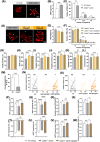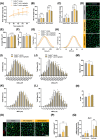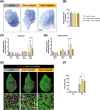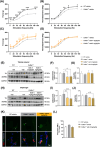Salbutamol repurposing ameliorates neuromuscular junction defects and muscle atrophy in Col6a1-/- mouse model of collagen VI-related myopathies
- PMID: 38984773
- PMCID: PMC11234414
- DOI: 10.1002/ctm2.1688
Salbutamol repurposing ameliorates neuromuscular junction defects and muscle atrophy in Col6a1-/- mouse model of collagen VI-related myopathies
Conflict of interest statement
The authors declare no conflicts of interest.
Figures




Similar articles
-
Collagen VI myopathies: from the animal model to the clinical trial.Adv Enzyme Regul. 2009;49(1):197-211. doi: 10.1016/j.advenzreg.2008.12.009. Epub 2009 Jan 6. Adv Enzyme Regul. 2009. PMID: 19162063 Review. No abstract available.
-
Col6a1 null mice as a model to study skin phenotypes in patients with collagen VI related myopathies: expression of classical and novel collagen VI variants during wound healing.PLoS One. 2014 Aug 26;9(8):e105686. doi: 10.1371/journal.pone.0105686. eCollection 2014. PLoS One. 2014. PMID: 25158062 Free PMC article.
-
Collagen VI is required for the structural and functional integrity of the neuromuscular junction.Acta Neuropathol. 2018 Sep;136(3):483-499. doi: 10.1007/s00401-018-1860-9. Epub 2018 May 11. Acta Neuropathol. 2018. PMID: 29752552
-
Sustained oral spermidine supplementation rescues functional and structural defects in COL6-deficient myopathic mice.Autophagy. 2023 Dec;19(12):3221-3229. doi: 10.1080/15548627.2023.2241125. Epub 2023 Aug 1. Autophagy. 2023. PMID: 37528588 Free PMC article.
-
A novel de novo COL6A1 mutation emphasizes the role of intron 14 donor splice site defects as a cause of moderate-progressive form of ColVI myopathy - a case report and review of the genotype-phenotype correlation.Folia Neuropathol. 2017;55(3):214-220. doi: 10.5114/fn.2017.70486. Folia Neuropathol. 2017. PMID: 28984114 Review.
References
Publication types
MeSH terms
Substances
Grants and funding
- #22360/AFM Telethon
- University of Padova
- GGP19229/Telethon Foundation
- P2022Y2A3L/Italian Ministry of Education, University and Research
- P20227YB93/Italian Ministry of Education, University and Research
- 201742SBXA/Italian Ministry of Education, University and Research
- HA3309/3-1/German Research Council
- HA3309/6-1/German Research Council
- HA3309/7-1/German Research Council
- National Center for Gene Therapy and Drugs Based on RNA Technology
- National Recovery and Resilience Plan (NRRP)
- Strengthening research structures for supporting the creation of National Centres, national R&D leaders on some Key Enabling Technologies
- Project CN00000041/European Union - Next Generation EU
- CUP B93D21010860004/European Union - Next Generation EU
LinkOut - more resources
Full Text Sources
